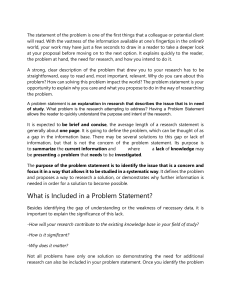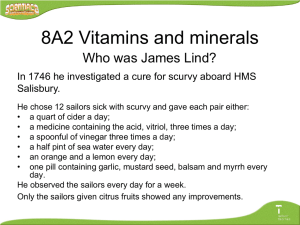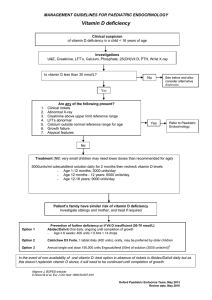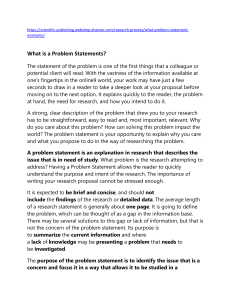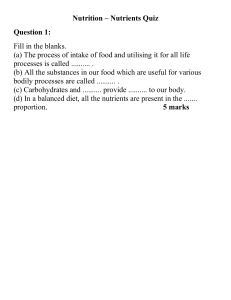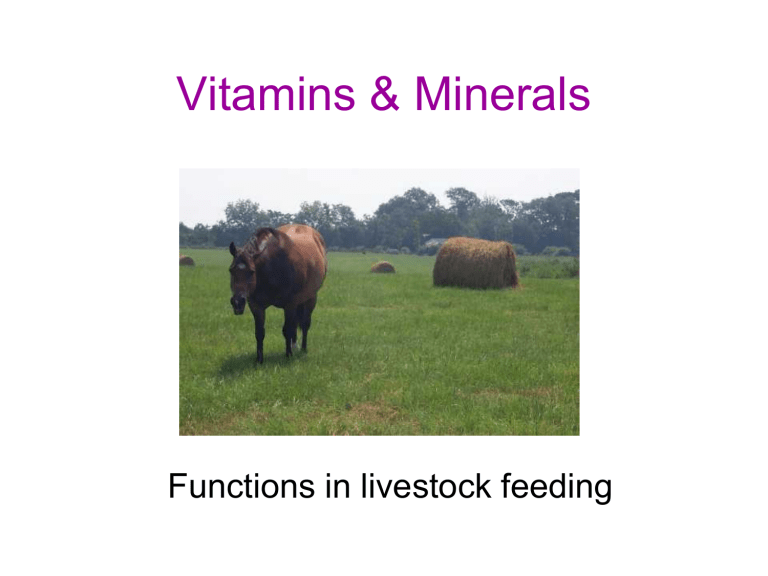
Vitamins & Minerals Functions in livestock feeding Vitamin Facts • Vitamins are essential organic nutrients, required in small amounts. • They cannot be synthesized by the body. Must be obtained by outside sources like diet, rumen bacteria & sun. • Required for growth, maintenance, reproduction and lactation. Classes of Vitamins Fat Soluble Vitamins: Water Soluble Vitamins: stored in tissues not stored in tissues, must have constant supply Examples A Examples D B, B1, B2, B6 & B12 E Niacin K Folic Acid C Function, Deficiency Signs & Sources Vitamin A Function: development healthy skin and nerve tissue. Aids in building up resistance to infection. Functions in eyesight and bone formation. ALL ANIMALS require a source of Vitamin A. It is important in the ration of pregnant females. Deficiency signs: retarded growth in the young, the development of a peculiar condition around the eyes known as Xerophthalmia, night blindness and reproductive disorders. Sources: whole milk, carotene, animal body oils (cod fish and tuna), legume forages and can be synthetically produced. Vitamin E Function: normal reproduction. Deficiency signs: poor growth, "crazy chick" disease, Muscular Dystrophy, "white muscle" disease in ruminants and swine and "stiff lamb" disease (affects the nerves and muscles). Sources: synthetic for poultry and swine, cereal grains and wheat germ oil, green forages, protein concentrates, oil seeds (peanut and soybean oil). Vitamin E rapidly destroyed in rancid or spoiled fats. That is why these may cause white muscle disease. Utilization of Vitamin E is dependent on adequate selenium. Vitamin D Function: is essential for the proper utilization of calcium and phosphorus to produce normal, healthy bones. Deficiency signs: retarded growth, misshapen bones (rickets), lameness and osteoporosis. Sources: Whole milk, sun-cured hays, forage crops, fish liver oils, irradiated yeast. Vitamin K Function: necessary for the maintenance of normal blood coagulation. Deficiency signs: blood loses its power to clot or the time needed for clotting is longer and serious hemorrhages can result from slight wounds or bruises. Sources: green leafy forages, fish meal, liver, soybeans, rumen and intestinal synthesis, and the synthetic compounds. Vitamin C (Ascorbic acid) Function: has an effect on the metabolism of calcium in the body (Not required in rations of farm animals.). Deficiency signs: none demonstrated in livestock. Human deficiency: scurvy (swollen and painful joints and bleeding gums) and brittleness of bones. Sources: citrus fruits, tomatoes, leafy vegetables and potatoes. Vitamin B1 (Thiamin) Function: required for the normal metabolism of carbohydrates. Deficiency signs: loss of appetite, muscular weakness, severe nervous disorders, general weakness and wasting (BeriBeri). Sources: raw, whole grains and especially their seed coats and embryos; fresh green forage; and yeast, milk and rumen synthesis. Vitamin B2 (Riboflavin) Function: necessary for normal embryo development, important in the metabolism of amino acids and carbohydrates. Deficiency signs: poor reproduction characterized by small litters and deformed young (cleft palate and clubfootedness) curly toe paralysis in chicks, digestive disturbances, general weakness and eye abnormalities. Sources: milk and dairy by-products, yeast, green forages, well cured hay (especially alfalfa), whole grains, wheat bran and synthetic riboflavin rumen synthesis. Mineral Facts • Essential inorganic nutrients, required in small amounts. • As many as 20 minerals may be required! • Required for growth, maintenance, reproduction and lactation. Who is Cap. KS Naclmg? The Macrominerals • • • • • • • Calcium Ca Phosphorous P Potassium K Sulfur S Sodium Na Chlorine Cl Magnesium Mg Calcium (Ca) Function: major component of bones and teeth and essential in blood coagulation, nerve and muscle function and milk and egg production. Deficiency signs: retarded growth, deformed bones in young animals (rickets), and soft shelled eggs and osteoporosis in older animals. Sources: milk, oyster shells and limestone. Sodium chloride Considered together because of a close biochemical relationship and are provided as common salt (NaCl) Function: required for the formation and retention, concentration and pH of body fluids, such as protoplasm, blood. Important in the formation of digestive juices and functions in nerve and muscle activity. Deficiency signs: poor condition and depressed appetite. Most farm produced feeds are deficient in these two minerals. Sources: salt supplements and injectable products. Phosphorus (P) Function: essential for the formation of bones, teeth, and body fluids. Required for metabolism, cell respiration and normal reproduction. Deficiency signs: similar to calcium deficiency, lack of appetite, poor reproduction and unthrifty appearance. Sources: dicalcium phosphate, bone meal, and low fluorine phosphates. Potassium (K) Function: retention and formation of body fluids, pH concentration of body fluid and rumen digestion. Deficiency signs: nonspecific and unlikely under most conditions but may have decreased feed consumption and efficiency. Sources: roughages. Grains are less than roughages . Manganese (Mn) Function: Fetal development, udder development, milk production and skeleton development. Deficiency signs: Abortions, reduced fertility, deformed young and poor growth. Sources: Most use trace mineralized salt. I Cu FeSe Mn Mozn! What’s that supposed to mean? The Microminerals Iodine (I) Copper (Cu) Iron (Fe) Selenium (Se) Manganese (Mn) Molybedenum (Mo) Zinc (Zn) Copper (Cu) Function: should be present in animal tissues for iron to be properly utilized, hemoglobin formation and synthesis of keratin for fair and wool growth. Deficiency signs: poor pigmentation of feathers, stringy wool, sway back lambs, lack of muscle coordination and anemia. Sources: forages and copper salts. Iron (Fe): Function: essential for the function of every organ and tissue of the body (Hemoglobin). Deficiency signs: seldom occurs in older animals, nutritional anemia, labored breathing and pale eyelids, ears and nose. Sources: forages and copper or trace mineral salts. Cobalt (Co) Function: required as a nutrient for the microorganisms in ruminants and thereby aids in rumen synthesis of Vitamin B12. Because swine cannot manufacture B12 from cobalt, the diets are supplemental with vitamin B12 instead. Deficiency signs: lack of appetite, loss of weight, rough hair coat, anemia, decreased milk and wool production and death in extreme cases. Sources: legume forages and salt containing cobalt. Magnesium (Mg) Function: similar to calcium and phosphorus. Deficiency signs: Animals are irritable, their heart beat is irregular and there is severe kidney damage. Sources: mineral supplements and ordinary feeds. Which nutrient deficiencies does Cap. KS have? Night blindness? A Blood won’t clot? K Poor posture? Ca & P Bleeding gums & Scurvy? C Lameness? D&E Childless/ reproductive dysfunction? B2 & A Vocabulary Review Nutrients: chemical substances in food that are used by the body to produce energy and tissues. Vitamins: essential organic nutrients, required in small amounts, that cannot be synthesized by the body. Required for growth, maintenance, reproduction and lactation. Vitamin deficiency: decline in health due to the lack of a vitamin in a ration. Vocabulary Review Fat soluble vitamin: a vitamin that can be stored and accumulated in the liver and other fatty tissues. Water soluble vitamin: a vitamin that cannot be stored in the tissues. Must be provided regularly as deficiencies can develop in a short time. Minerals: essential inorganic compounds, required in small amounts. Required for growth, maintenance, reproduction and lactation. Macrominerals: required in large amounts. Microminerals required in small amounts.

